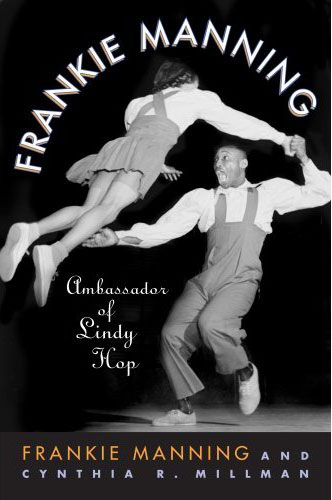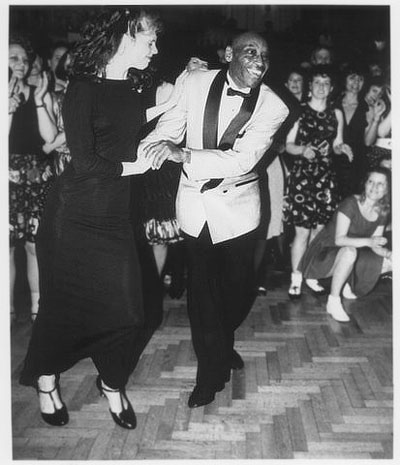The street jazz band The Blue Vipers of Brooklyn were featured in the december podcast of Hey Mr Jesse.
Now I found an interview with the band on the New York radio show Soundcheck on WNYC. Listen to the interview:
It's cool that lindy hop and balboa are mentioned in the interview.
The band also have won The Subway Idol contest on The Morning Show with Mike and Juliet. Take a look at The Blue Vipers of Brooklyn on The Morning Show.
I would like to have their latest cd "Forty Days And Forty Nights" (available at cdbaby.com).
What do you think of the The Blue Vipers of Brooklyn? Tell me.
[Via Yehoodi]
Friday, January 4, 2008
Blue Vipers of Brooklyn - radio interview and Subway Idol
Posted by
Henrik
at
1:38 PM
0
comments
![]()
Labels: Blue Vipers of Brooklyn, interview, radio, subway idol
Sunday, December 2, 2007
Balboa history: Interview with Dwight Lupardus by Peter Loggins
All of you that are intrested in dancing balboa will like this interview with balboa dancer Dwight Lupardus who talks about the history of balboa in southern California. He talks about the dance itself, the dancers and the social context of the dance. He is interviewed by Peter Loggins, a noted swing dance historian.
The interview is about 1 hour long and is divided into 8 pieces on YouTube:
If you want to know more about dance history, check out dancehistory.org which is run by Peter Loggins.
I don't have the time right now to give a summary of what is talked about in each part but if you have the time, please comment this post and write a summary yourself.
What do you think of the interview with Dwight Lupardus about the history of balboa? Tell me.
Posted by
Henrik
at
12:15 PM
0
comments
![]()
Labels: balboa, Dwight Lupardus, history, interview, peter loggins
Thursday, May 17, 2007
Interview: Cynthia Millman: co-author of "Frankie Manning: Ambassador of Lindy Hop"

The autobiography by Frankie Manning: Frankie Manning: Ambassador of Lindy Hop has just been released. Cynthia Millman is co-author of the book and I was curious about her so I did an interview with her to find out more about her and the process behind writing the biography.
Can you tell me a little bit about yourself? What do you do for a living? When did you start dancing?
I loved dancing as a kid, but didn’t start training until age 12, after seeing a ballet demonstration. Since then I’ve explored many, many forms of classical, modern, and ethnic dance, but once I discovered swing dancing in the mid 1980s, that was it. I have a master’s degree in dance and dance education, and taught dance (mostly to children) and performed (on and off) for 25 years. Somewhere in there, I made a career shift. I earned a master’s in library science, and have been a children’s librarian for the last fifteen years, currently at The Town School in Manhattan.
When did you first meet Frankie?
I first met Frankie at a dance in 1986, which I describe in the book’s introduction. I didn’t really get to know him until I began performing with the Big Apple Lindy Hoppers in 1990. It was while hearing his stories at dinner after rehearsals that I first realized what an interesting life he had lived, and how gifted he was at describing his experiences.
How would you describe Frankie Manning to someone who doesn’t know him?
Frankie Manning was one of the main creators of the lindy hop at Harlem’s Savoy Ballroom during the 1930s. His choregraphic innovations, especially the air step and synchronized ensemble routines, helped catapult the lindy from ballroom to stage and screen. Frankie’s choreography for and performances as a lead dancer with Whitey’s Lindy Hoppers helped popularize the lindy and disseminate it across America and around the world. With the demise of the Swing Era, Frankie took a “temporary” job in the Post Office . . . and ended up working there for 30 years! His rediscovery by a new generation of swing dancers and his professional comeback were a driving force in the swing dance revival that began in the 1980s and is still going strong. Today, at 93, Frankie has a packed teaching schedule and travels constantly to share with others the joy that swing dancing has brought him. An inspiration to us all, Frankie is as beloved for his marvelous personality as he is for his vital role in American dance history.
Frankie is one of my favorite people in the world, and collaborating on his autobiography was one of the greatest experiences of my life.
How come you started to write the book about Frankie Manning?
In 1987, I interviewed Frankie Manning for an article about the swing dance revival for a small local newspaper in Manhattan. I subsequently interviewed him for a master’s thesis project, an extensive exhibit on the history of swing dancing (which showed at swing dance events in New York City, Herrang, London, and Toronto), and for articles in Dance Magazine and The International Encyclopedia of Dance. In 1993, Frankie and I began doing educational presentations on lindy history that included lecture, interview, demonstration, and video clips. Around this time, I realized that I was completely enchanted by the history of swing dancing and asked Frankie if we could do a book together. Happily, he said yes.
Frankie Manning dancing with Cynthia Millman at CAN'T TOP THE LINDY HOP! during a birthday dance on the occasion of his 80th birthday party in New York City, 1994. Photographer: Timothy Swiecicki.
What is your favorite story from the book?
I love all of Frankie’s stories, but the one that stands out for me is when he danced with Betty Grable at a USO show in New Guinea during World War II. In addition to being a fun story, I feel that it illustrates so much of what Frankie is all about: his ability to make the best of a bad situation with incredible pluck and humor; his use of dance to connect to individuals and audiences; his love of entertaining people and lifting their spirits with his dancing; his professionalism as an entertainer; his respect for musicians; his personal charm; and his ability to disable racial prejudice at a time when it was so deeply entrenched in and so openly a part of American culture.
I also find his story about Sergeant Montgomery very moving. It’s one of the first stories I ever heard Frankie tell, and I’ll never forget hearing it that first time.
Now that the book is done, do you have any other subjects that you would like to write about?
As a children’s librarian, I have quite a few ideas for children’s books. I’m also interested in doing some articles on holistic health practices and meditation. And I’m considering some other research projects in the swing dance area.
Is there anything else you would like to mention?
Just that I hope everyone enjoys reading about Frankie Manning's life. Part of why we were able to get a publisher was because we could demonstrate to Temple University Press that there was an extensive international audience for Frankie’s story. Thinking about sharing the book with all of you helped keep us going during the lengthy process of getting that rich, long life into the pages of a book.
Thank you, Cynthia Millman, for taking time to answer the questions!
Thanks for giving me the opportunity to talk about the book.
Update: Read my book review here.
Order Frankie Manning: Ambassador of Lindy Hop at Amazon.com. Maybe join the campaign to make the book a best seller?
What do you think of this interview? Got other questions for Cynthia Millman? Tell me.
Posted by
Henrik
at
12:05 AM
7
comments
![]()
Labels: ambassador of lindy hop, autobiography, biography, book tips reviews, Cynthia Millman, frankie manning, history, interview, lindy hop, swing dancing
Tuesday, February 20, 2007
Frankie Manning book interview
Frankie Manning is interviewed in the latest podcast of Yehoodi radio about his upcoming autobiography: Frankie Manning: Ambassador of Lindy Hop.
In the interview Frankie tells some stories from his life, he talks about segregation and when he was enlisted in world war II. Despite such serious topics he somehow always stays positive, laughing like just he can.
Since Frankie also has sold movie rights for book, he also talks little about who might play him in a movie. (Update: That's a joke, folks, don't start any rumors)
The segment starts 14:30 into the podcast, if you want to jump directly to the interview, it's 18:45.
Download the podcast (22 MB, mp3)
Preorder Frankie Mannings autobiography from Amazon.
Read my earlier post about the Frankie Manning book.
What do you think after listening to the interview? Tell me.
Posted by
Henrik
at
10:24 AM
2
comments
![]()
Labels: ambassador of lindy hop, book tips reviews, frankie manning, interview, Yehoodi
Tuesday, January 16, 2007
Interview with Ralph Giordano, author of the book Social Dancing in America

Part 1: How come you wrote a book about social dancing?
[Part 2: Which dances do you write about in the book?]
I teach part-time at the City University of New York and have been writing for historical journals and the thought of combining an historical/cultural work with my own love of social dancing was intriguing.
My wife and I have danced in over 23 states in America and six other countries, and visited hundreds of dance clubs, probably a thousand or more if you include outdoor dance events. A very good tool that I learned from architecture is the empirical study of the movement of people when they do not know that they are being observed. In that same sense I was obviously heavily involved in actually dancing or learning a dance style. In the kinetic motion of dancing it is extremely important to just try and move with the music. In that same end it was extremely important being within the social dance environment and also visiting the Cecil Sharp House in London as well as taking a series of classes in English Country-dancing. My wife and I attended and it became an invaluable aid when I was researching the written description of the 18th century dances that I fully understood them because of our time actually performing the steps.
So as it turns out, to date this is the first book of its kind that has put together both a general interest reader and a scholarly work that discusses social dancing in a complete social, cultural, economic, political, and historical context. Many social dance books of the period simply provided descriptions and step-by-step instructions on “how to dance” as opposed to why people dance. My book also provides a consistent theme that contemporary dances and the associated music and fashion were more often attacked by forces of social morality and often labeled the newest dance trend as “scandalous.”
This book is not a book to teach people “How to Dance” there are literally thousands of publications and hundreds of dance studios available to do just that. This book is an attempt to provide a clear understanding of what was involved in the basic patterns and rhythms of the dance, the origins, the popularity, but most importantly to place each in a historical and social context. This book is about the dances themselves and their importance in a social context. Therefore, each chapter contains a brief introduction of the social, political, and cultural climate. The book is about how individual Americans; mainly couples interacted in a social dance setting.
Posted by
Henrik
at
2:32 PM
1 comments
![]()
Labels: book tips reviews, dance, history, interview, Ralph G. Giordano, social dancing


